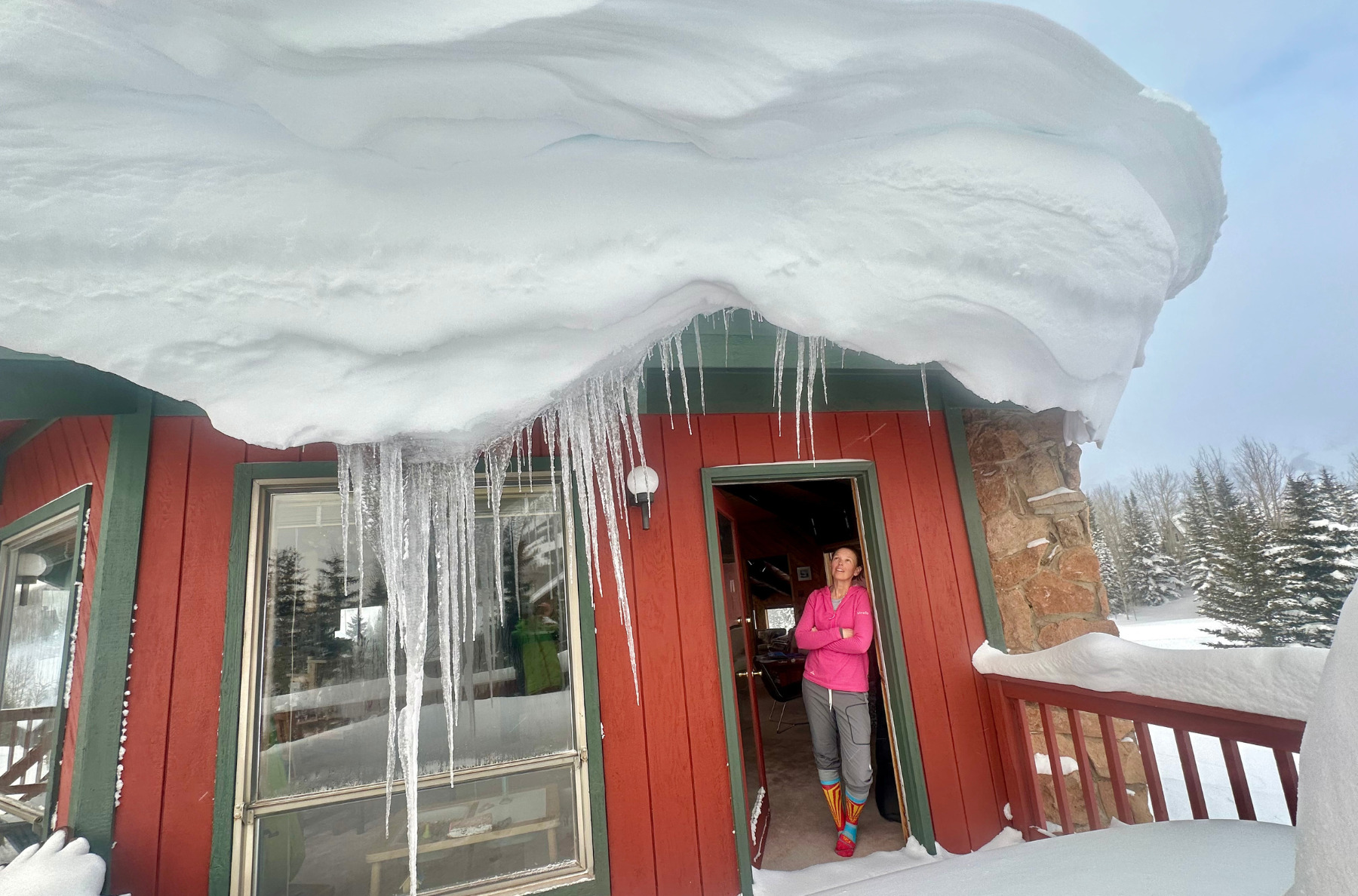
Intro
Whether it’s for skiing, biking, running, or any other activity, an ideal combination of base, mid, and outer layers can make your time outdoors a whole lot more — or less — enjoyable.
Midlayers and other insulators are a vital part of this, especially when it comes to balancing cold temperatures with high-output activities. As we’ve discussed in our Layering 101 article, we’ve now got a greater variety of layers to pick from than ever before, which is great in terms of having options, but it also means narrowing down all of them becomes trickier.
In this roundup, several of our reviewers discuss a number of midlayers and other insulative layers that they’ve been using over the past couple of years, outlining how each one stands out, what it does best, and where it might make sense to go with something else.
Here, we’ll be focusing on newer and updated women’s pieces that we haven’t yet discussed on our site, but for even more options, check out our Midlayer Roundup from 2022, and our other midlayer reviews. The products here were tested by our female reviewers, but many are available in men’s and women’s sizing, as is the case with many of the pieces that our male reviewers discussed in our other Midlayer & Insulation Roundup this season.
Ortovox Swisswool Piz Segnas Jacket (W)
MSRP: $330
Fabric: 100% polyamide
Insulation:
Front, back, shoulders, & outer sleeves: 90-g Swisswool (80% virgin wool / 20% polylactide)
Underarms & sides: 60-g Swisswool (80% virgin wool / 20% polylactide)
Measured Weight: 255 g
Size Tested: Small
Reviewer: Kristin Sinnott (5’8”, 135 lb / 172 cm, 61 kg)
With only one pocket and minimal features, the Piz Segnas Jacket is very streamlined but also surprisingly functional. The lightweight (90-g/m2 and 60-g/m2) Swisswool insulation provides enough warmth to be worn on cool days as an outer layer but it’s warm and lightweight enough to work as a great midlayer when the temperature plummets. As a midlayer, I like to wear it under my Ortovox Deep shell — unlike some of my bulkier insulated layers, the Piz Segnas Jacket is very compatible and it provides a nice fit under even fairly slim shells.
What initially drew me to this jacket were its wool insulation and lack of a hood. I’m not a fan of hooded midlayers since they tend to bunch up too much around my neck and end up poking me in the neck, which leads me to unzip them. I’d say the collar on the Piz Segnus is neither too tall nor too tight. It’s low and loose enough to work well with my hooded ski jackets but it still offers enough coverage for my neck when worn as an outlerlayer.
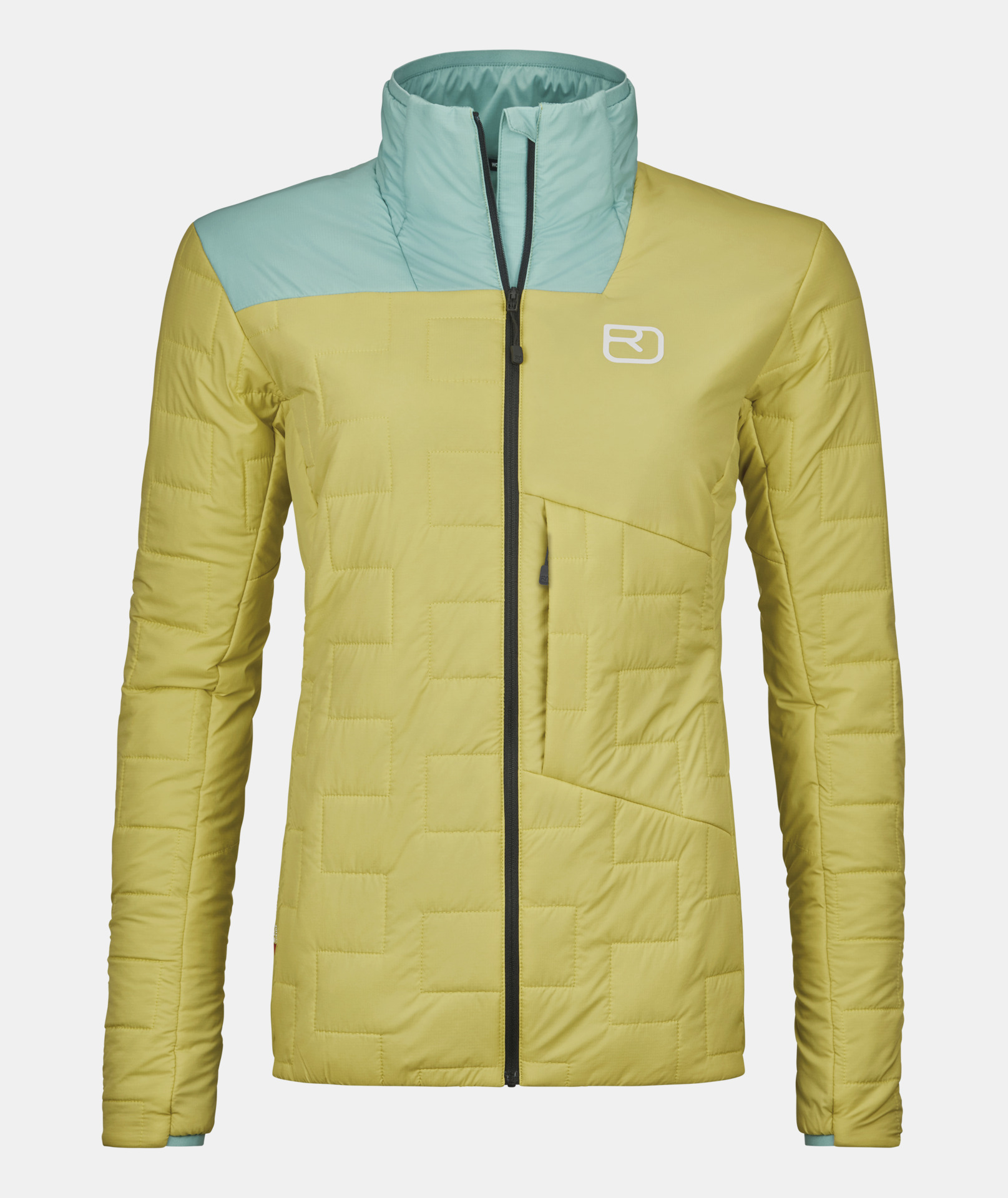
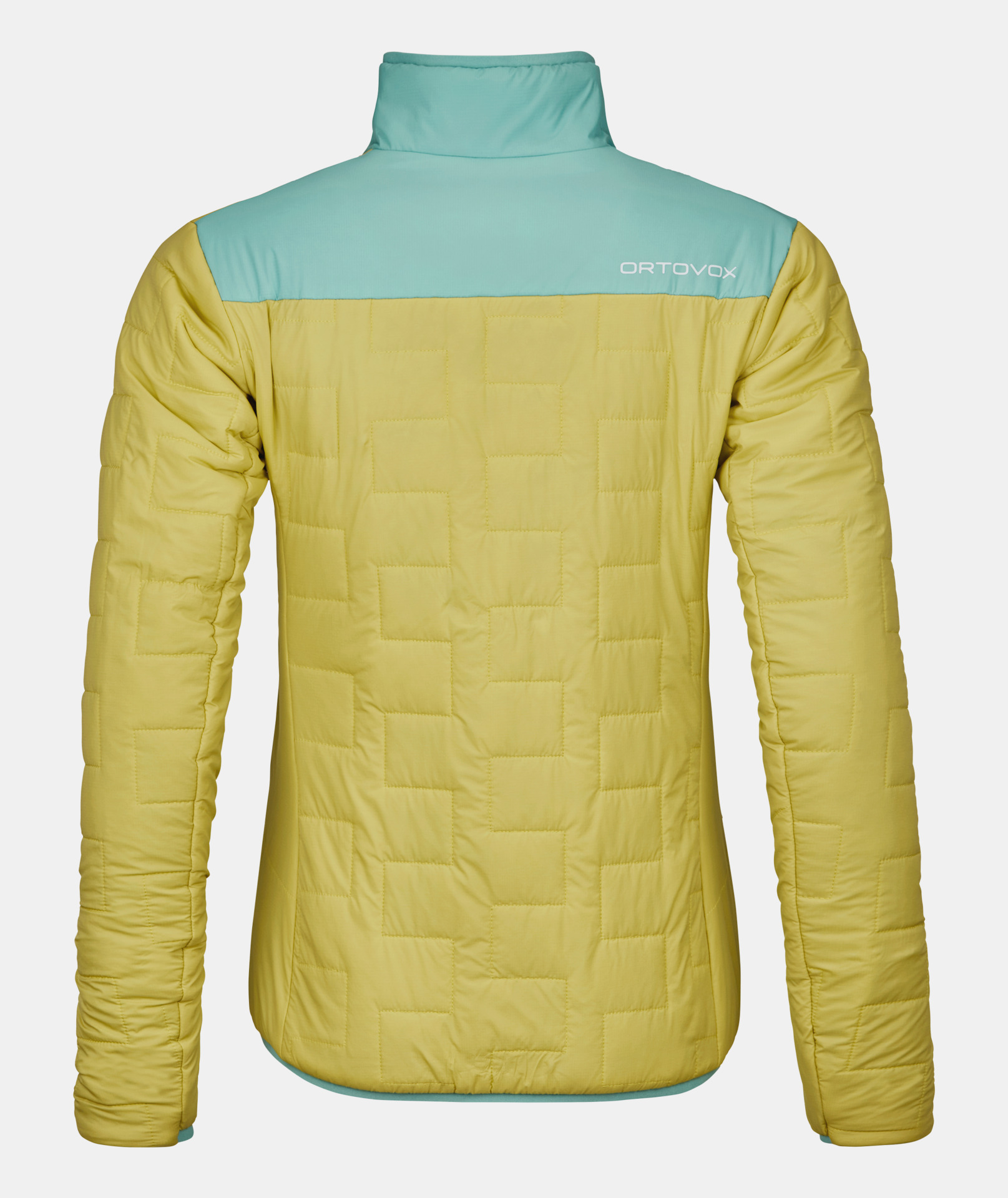

For those of you who appreciate hoods, Ortovox has you covered; they offer a hooded and non-hooded version of this jacket, and both are available in men’s and women’s fits.
For the past year, the Piz Segnus has been my go-to insulator on cool days. I like that it doesn’t look like a traditional puffy jacket, and it’s soft and quiet. Its wool insulation is minimally bulky and designed to put the heavier, 90-g insulation where it’s needed most – on the front, back, shoulders, and outer sleeves. On the sides and underarms, it features a lighter, more breathable 60-g version of the insulation.
The Piz Segnus only has a single pocket and it’s located midway down on the left side — not quite high enough to be a chest pocket, but not so low as a handwarmer pocket. This pocket is large enough to fit my rather large iPhone, but anything heavy like that unevenly weighs down the jacket, giving it a less streamlined and somewhat lopsided look.
The Piz Segnas is the only wool-insulated piece I’ve worn and I’ve been impressed by its warmth-to-weight ratio and breathability — it’s not ultra-warm, but provides a very versatile level of warmth and breathability for a midlayer while still being pretty light and low-profile. It’s also worth noting that Ortovox says the Piz Segnas is climate-neutral product and it’s made in Europe. For those looking for a light insulating piece that can be used all year long, the Piz Segnus is a good option.
Strafe Women’s Basecamp Hoodie
MSRP: $149 (on sale for $74.50 as of publishing)
Fabric: Polartec PowerGrid (92% polyester / 8% Spandex)
Measured Weight: 188 g
Size Tested: Small
Reviewer: Kristin Sinnott (5’8”, 135 lb / 172 cm, 61 kg)
The Basecamp hoodie is a lightweight, slim-fitting shirt that can be worn as a light midlayer or as a heavy baselayer. Its Polartec PowerGrid fleece fabric is very similar to Patagonia’s R1 fabric, but the Basecamp Hoodie’s fabric is slightly thinner and it has a much slimmer fit than the last R1 I used. I’m wearing the Basecamp Hoodie in my usual size Small and I only ever wear a very thin long-sleeve baselayer or a short-sleeve shirt underneath — its fit seems designed to be worn pretty close to the body in your layering system.
What makes the Basecamp Hoodie stand out to me is how it bridges the gap between a baselayer and a midlayer. It is comfortable to wear as a next-to-skin layer while being warmer than most other baselayers, and I’ve found that it ads some versatility to my closet that was previously lacking. Its slightly stretchy fabric is soft against the skin, provides good mobility, the torso and sleeves are plenty long, and it’s pretty warm compared to other baselayers while still breathing quite well. I also like the true ½-zip design, which adds a ventilation option. I most often find myself wearing the Basecamp Hoodie with a light T-shirt underneath, especially for warm days on the hill when a baselayer + insulated midlayer combo would be too warm and only wearing a single baselayer would be too cold.
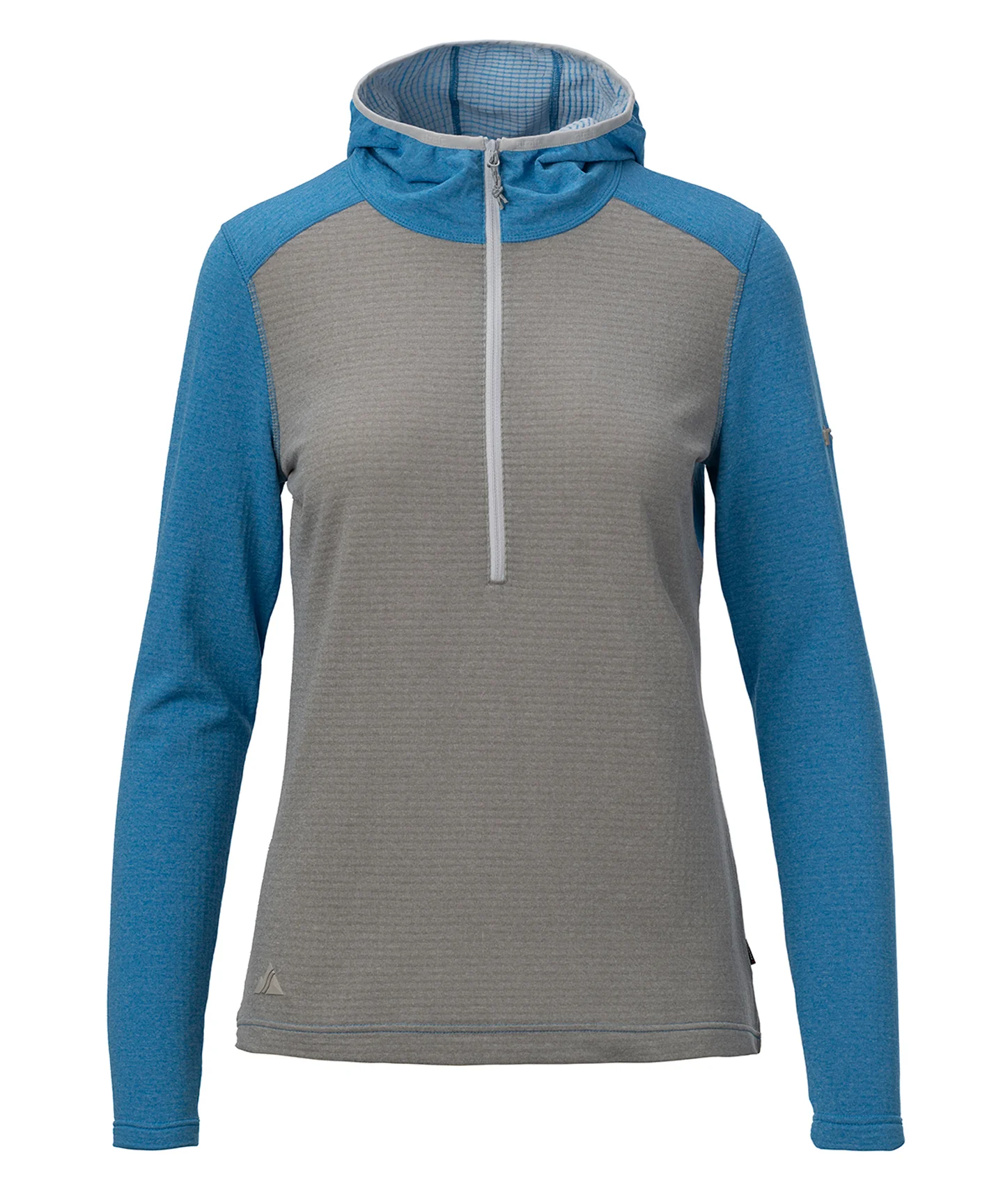
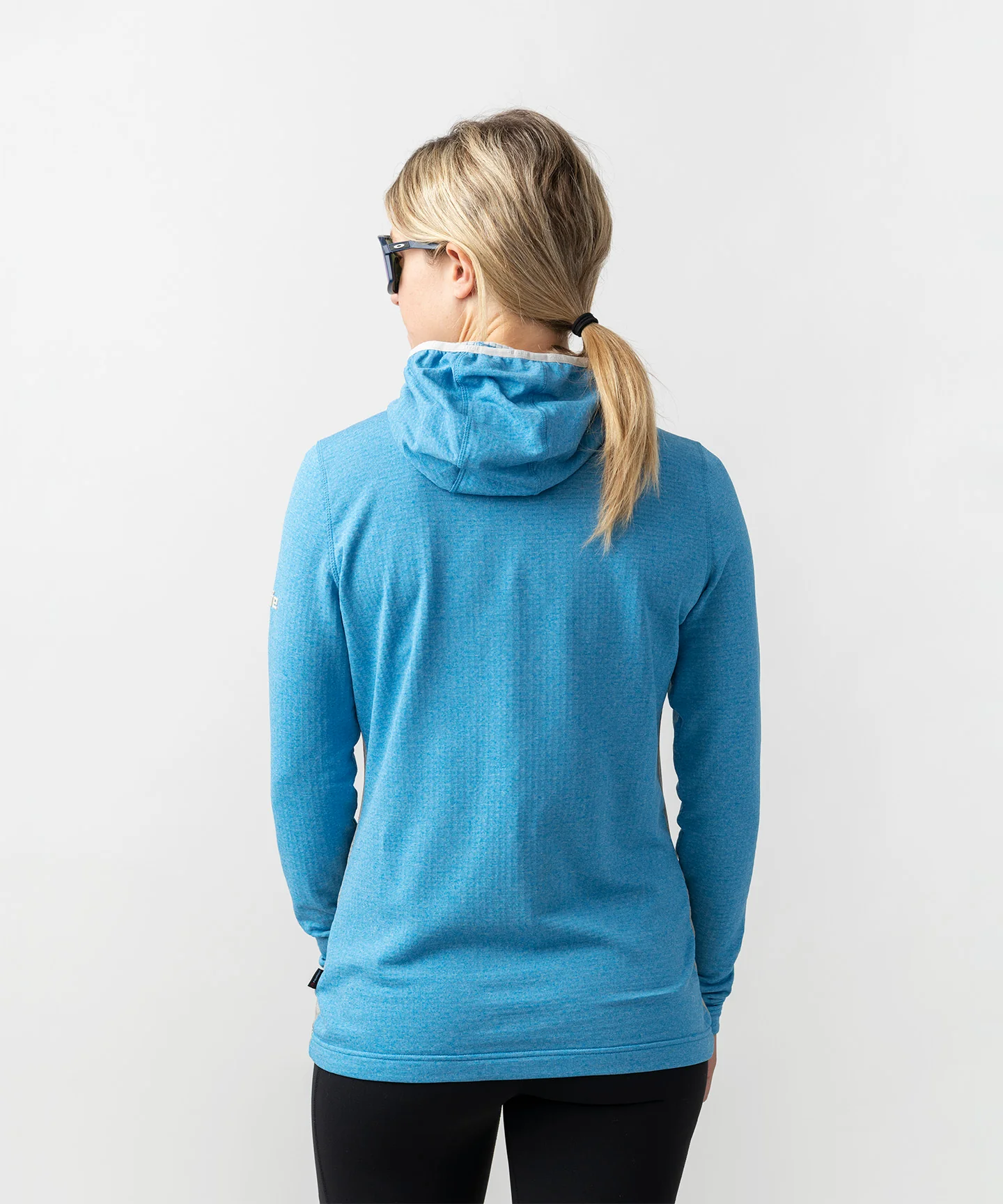

Outdoor Research Women’s Vigor Grid Fleece Pullover Hoodie
MSRP: $110
Fabric: ActiveTemp grid fleece (94% Polyester / 6% Elastic | Bluesign approved)
Measured Weight: 260 grams
Size Tested: XS
Reviewer: Sascha Anastas (5’1”, 105 lb / 155 cm, 47 kg)
The Vigor Fleece Pullover is one of the lighter layers included in this roundup but it stands out due to its streamlined pullover style, breathability, and versatility. The Vigor Fleece Pullover is made of a grid-style fleece that’s treated with Outdoor Research’s thermoregulating ActiveTemp treatment. In short, this treatment consists of a non-Newtonian polymer that turns to a liquid when cold and a solid when warm (opposite of most materials). As a result, Outdoor Research says that their ActiveTemp fabrics do a better job of adapting to your body temperature and sweat, absorbing sweat when cold but then releasing it and letting it evaporate when warm.
With that in mind, the Vigor Grid Fleece Pullover is meant to be a next-to-skin or near-skin layer for a variety of high-output activities.
The inner grid side of its fabric feels very similar to my well-loved (now probably vintage) Patagonia R1 fleece pullover. The Vigor’s exterior feels a bit less thick and stiff than the R1, even after using the latter for years.
One of the Vigor Grid Fleece Pullover signature features is its zipperless, hooded silhouette, which functions as a hood, neck gaiter, and balaclava. That hood / balaclava is quite baggier and boxier than many other baselayer pullovers / hoodies I’ve used, such as the Patagonia Capilene Air Hoody — to the point that, when I am not wearing the hood, it feels like I am wearing a cowl-neck sweater. I love this for lounging, but it does mean the hood can be a bit bulky when under multiple other layers. The hood also features a ponytail slit, which turns out to be quite useful when I wear the hood up under my ski helmet.
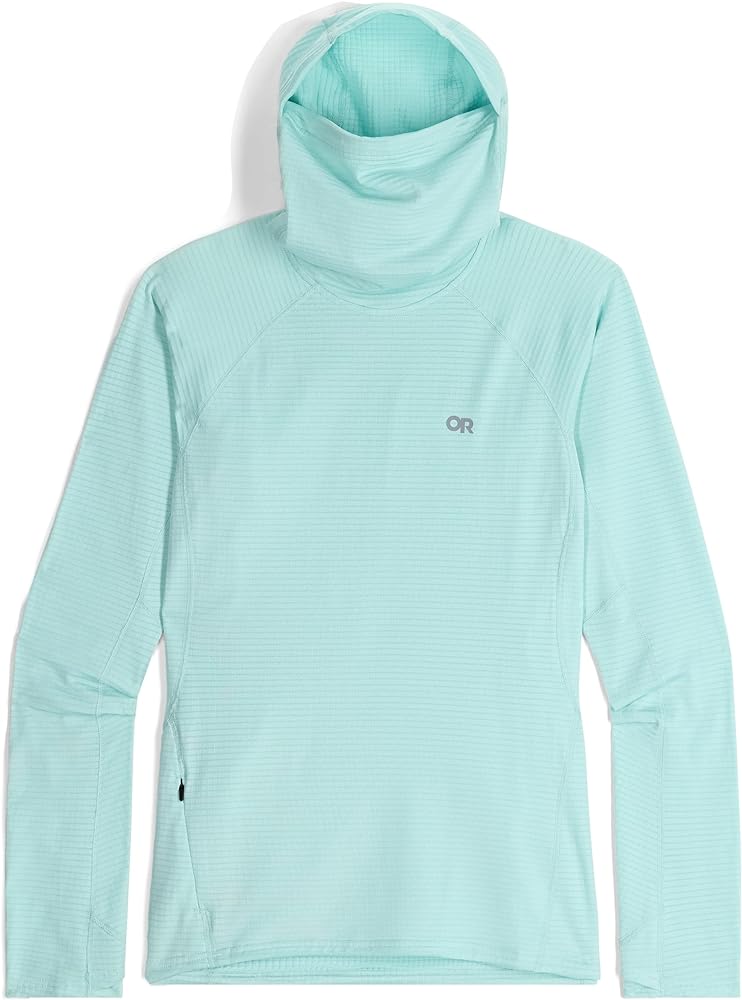
The Vigor Grid Fleece Pullover’s sleeves are slightly on the longer side, but when worn with the thumb slits to hold up the extra sleeve material, the length does not feel bulky to me. There is also a small triangular side pocket on the right lower side seam, which is just barely big enough to fit a mobile device — albeit awkwardly. It seems more ideal for smaller things like keys, cards, etc.
Overall, I found the length of the Vigor Grid Fleece Pullover to be a little on the long side. On my petite frame, the size XS (my usual size) actually covered my entire pelvis and buttock area. This did make for a substantial extra layer of insulation under my ski bibs and minimized any problems with the layer riding up when skiing, hiking or doing strenuous activities, but makes it less ideal for casual wear or apres attire.
The Vigor Grid Fleece Pullover’s flat seams and contoured cut make it feel very manageable under heavier layers. As a result, it can serve as a warm baselayer for cold activities, a light midlayer when worn over a thin baselayer, or as a very breathable outer layer for high-output activities in cool temps. While it’s far from the warmest, the Vigor Grid Fleece Pullover is one of the most breathable and best-wicking pieces here.
The bottom line is that the Vigor Fleece Pullover has been a very versatile lighter midlayer / heavier baselayer that I’ve found really useful for a wide array of cool- and cold-weather activities, higher-output ones like ski touring and cold-weather biking. Overall, the Vigor Grid Fleece Pullover will likely remain a staple in my closet and perhaps even replace my beloved Patagonia R1 zip-up fleece.
Rab Women’s Xenair Alpine Light Jacket
MSRP: $220
Fabric:
Shell: 20D Pertex Quantum Air nylon w/ DWR finish (47 g/m2)
Lining: 20D Recycled Nylon (41 g/m2)
Insulation:
Front, back, top of sleeves, & collar: 60-g/m2 Primaloft Gold Insulation Active+ (55% Recycled Content)
Rest of jacket: 40-g/m2 Primaloft Gold Insulation Active+ (55% Recycled Content)
Measured Weight: 446 g
Size Tested: XS
Reviewer: Kristin Sinnott (5’8”, 135 lb / 172 cm, 61 kg)
I’ve been wearing the Xenair Alpine Light for the past few months and I find I reach for it most often as an outer layer for cross-country skiing, winter walks, and to wear around town while running errands. The Xenair Alpine Light falls somewhere in the middle of the spectrum when it comes to insulated jackets that roughly fall into the “midlayer” category. It’s not as warm as my much bulkier Outdoor Research Women’s Cold Front Down Hoodie, but the Xenair Alpine Light is warmer than the Ortovox Piz Segnus Jacket.

What I like about the Xenair Alpine Light is it provides enough warmth to be appropriate as my outer layer while running around town during the winter, but it’s not so warm that I’ll burn up when the day turns out to be warmer than I expected. This is largely due to its impressive breathability. Still, unlike the Piz Segnus Jacket, I find the Xenair Alpine Light too warm to wear around the house on cool days.
The sizing on the Xenair Alpine Light is a little different than most other midlayers I’ve used from other brands. I typically wear a size Small or Medium for tops, but the size Extra Small Xenair Alpine Light is a great fit for me. Its sleeves are long — they cover my knuckles— and the torso is plenty long, too, extending 4.5 in / 11 cm past my hip bone. Since I’m in a smaller size than I normally wear, I’m not sure I’d call the Xenair Alpine Light particularly narrow, but it’s on the trimmer side of things in that regard; most XS jackets would be way too short and narrow for me, but this has a great overall fit with fairly narrow sleeves and a narrow cuff. However, I don’t have wide hips; if I did, it would be hard to get the Xenair Alpine Light fully zipped over them.
The Xenair Alpine Light does have a double-sided main zipper and can be unzipped from the bottom for those needing a bit of extra space around the hips. Its articulated sleeves are also extremely well designed — I can windmill my arms and the torso of the jacket doesn’t move. This is a big plus for cross-country skiing.
The Xenair Alpine Light’s pockets (2 zippered chest pockets, 2 zipper handwarmer pockets) are well designed and provide more than enough space for me regardless of what I’m doing. And the jacket doesn’t get easily weighed down or look less streamlined when I have heavy objects in its pockets.
Similar to the Piz Segnus, the insulation in the Xenair Alpine Light is thicker where it’s most needed. It features 60-g Primaloft Gold Active+ through the front, back, top of sleeves and collar, while a lighter 40-g version of the same Primaloft Gold Active+ insulation is used through sides, underarms, spine, and top of hood. Overall, this Primaloft Gold Active+ insulation feels light and more breathable than typical “puffy” insulations (aided by the Xenair Alpine Light’s breathable lining and mapped insulation placement). On a recent skate-ski that started cold and windy and ended warm and calm, I was impressed by how the Xenair Alpine Light managed to block out the wind while remaining quite breathable, given that wind resistance and its overall warmth.
If you run hot, the Xenair Alpine Light wouldn’t be my top pick as a midlayer you’ll frequently run under a shell, but it’s a great outer-layer insulator for cold temperatures, even during high-output activities, and can also work as a midlayer on very cold days / for those who run quite cold.
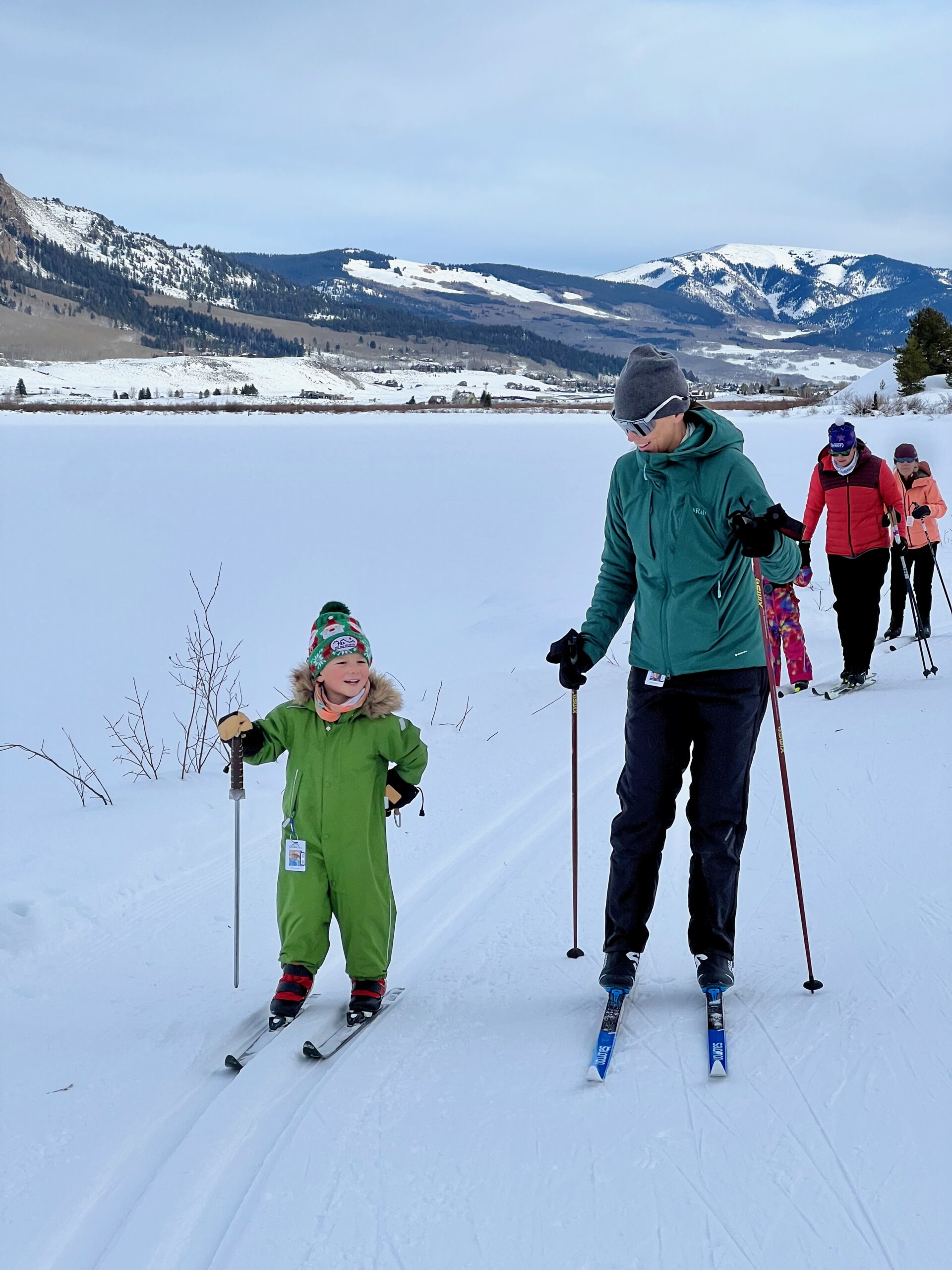
Stio Women’s Fernos Insulated Knicker
MSRP: $199
Fabric: 50D Relance™ Primeflex (100% Polyester | 85-g/m2)
Insulation: 40-g/m2 PeakFill™ Active Insulation (50% Polyester / 50% Recycled Polyester)
Measured Weight: 291 g
Size Tested: Medium
Reviewer: Kristin Sinnott (5’8”, 135 lb / 172 cm, 61 kg)
As far as my pant layering system for skiing, I used to only ever wear a thin baselayer underneath an uninsulated shell pant and I’d never get cold. Well, my body no longer regulates temperature like it used to and I now find that my legs get cold with that setup, especially during mid-winter resort days. Over the past few years, I’ve found that insulated midlayer bottoms are a great way to keep my legs (and rear) warm on frigid days, especially if I’m not wearing insulated shell pants. I’ve become a fan of a whole lot of insulated products lately, especially if they’re also breathable, and the Stio Fernos Insulated Knicker fits this criteria.
The Fernos Insulated Knicker is soft to the touch and its microfiber fabric instantly feels warm against my skin. Thanks to its soft fabric and light 40-g insulation, I find myself wearing the Fernos as a midlayer on the slopes just as much as I’ve worn it around the house or cabin. This is largely thanks to its comfy and quiet fabric, and because its pocket on the lower leg is large enough to accommodate my phone or other similarly sized items.
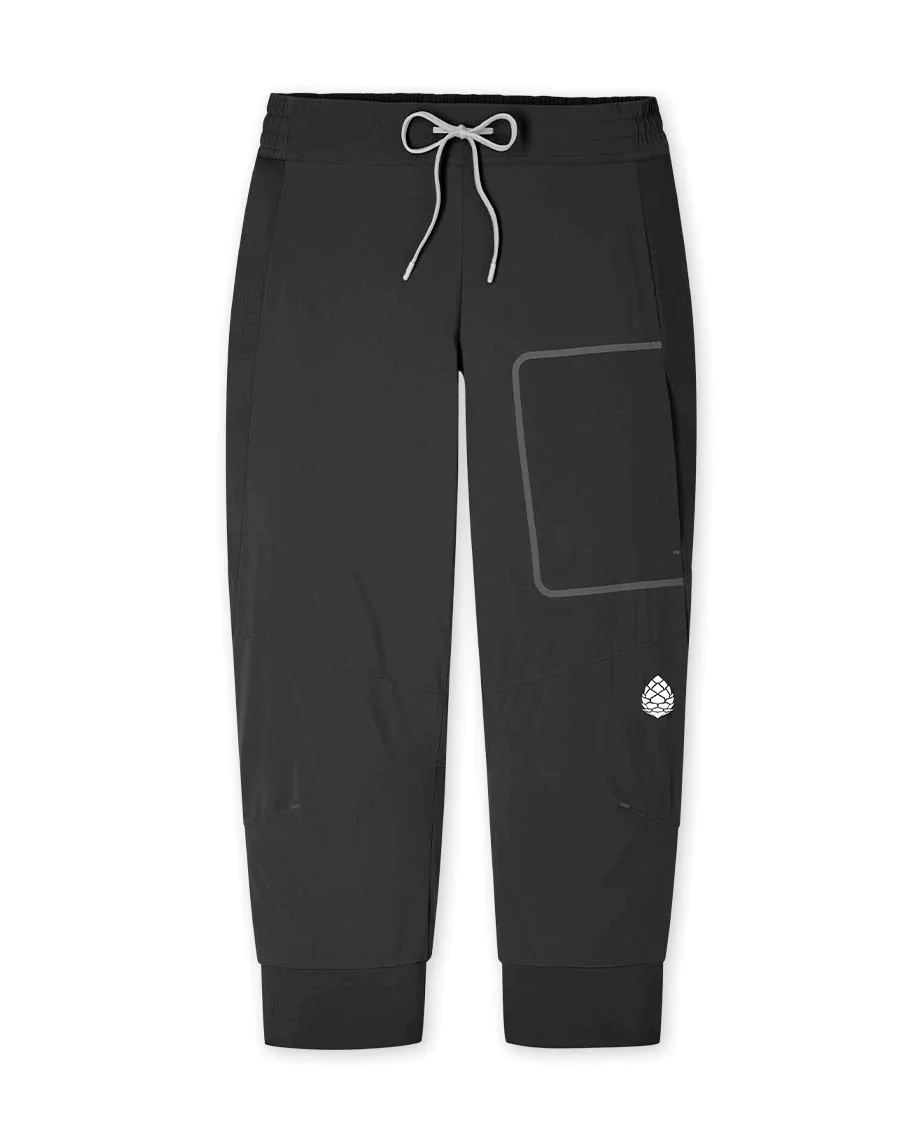
While I don’t love adding heavy items like a phone to the pocket, the Fernos Insulated Knicker’s elastic, drawstring waist keeps the pants up even if heavy objects are added.
The Fernos Insulated Knicker provides a notable amount of warmth without adding too much bulk. The Knicker length pairs well with ski / snowboard boots, but because of where the cuff falls and the fact that the cuff isn’t overly tight, I find I always need to wear these with a baselayer underneath. The overlap between the cuff of the knickers and the top of my ski sock is pretty minimal, and whenever I get onto a chairlift and/or bend my knees, the Knicker rises just enough to create a gap between the two. Even under a pair of ski pants, this gap allows cool air to seep in. For reference, the inseam on the size Medium measures 21 in / 53.5 cm.
I have been wearing the size Medium for a few years now and I do think I could have downsized for a snugger fit, especially since the knickers have stretchy side panels, but the Medium does allow me to comfortably fit a baselayer underneath. If you’re looking for a warm but not bulky midlayer for cold chairlift laps, the Fernos Insulated Knicker is a great option. And if you’re not as concerned with minimizing bulk around boot cuffs, Stio also makes these in a full-length pants.
Kari Traa Eva High Waist Capri
MSRP: $140
Main fabric & lining: 100% polyester
Contrast Fabric: 91% Polyester / 9% Elastane
Insulation: Down (80%, Feather 20%)
Measured Weight: 187 g
Size Tested: Medium
Reviewer: Kristin Sinnott (5’8”, 135 lb / 172 cm, 61 kg)
The Eva High Waist Capri brings a more traditional down-jacket approach to midlayer bottoms. With down fill on the front and back of the legs, these capris are quite warm, but slightly bulkier than the Stio Fernos Insulated Knicker and Strafe’s Alpha Insulator Pant. The Eva’s fabric is primarily polyester and it has a soft but slick feel to it. The stretch panels on the inside and outside of the leg provide some mobility, but when compared to the Fernos, the Eva High Waist Capri moves around much more while skiing, walking, etc.
The waistband on the Eva consists of a double snap with a zipper and elastic at the back. I find that the waist doesn’t stay in place very well — the pants stay up, but when sitting, there’s a gap in the back (your mileage may vary, depending on your dimensions). These capris are designed to sit above the cuff of a ski / snowboard boot and they work well in that regard, but for me personally, I find they ride up a bit too high for my liking. The polyester / elastane cuff fits more snuggly than the Fernos Knicker and I like that air can’t flow up the cuff, but the pant length is just a bit too short on me. The size Medium Eva’s inseam measures 20.5 in / 52 cm, which is only slightly shorter than the Fernos, but the Eva rides up to just under my knee when sitting.
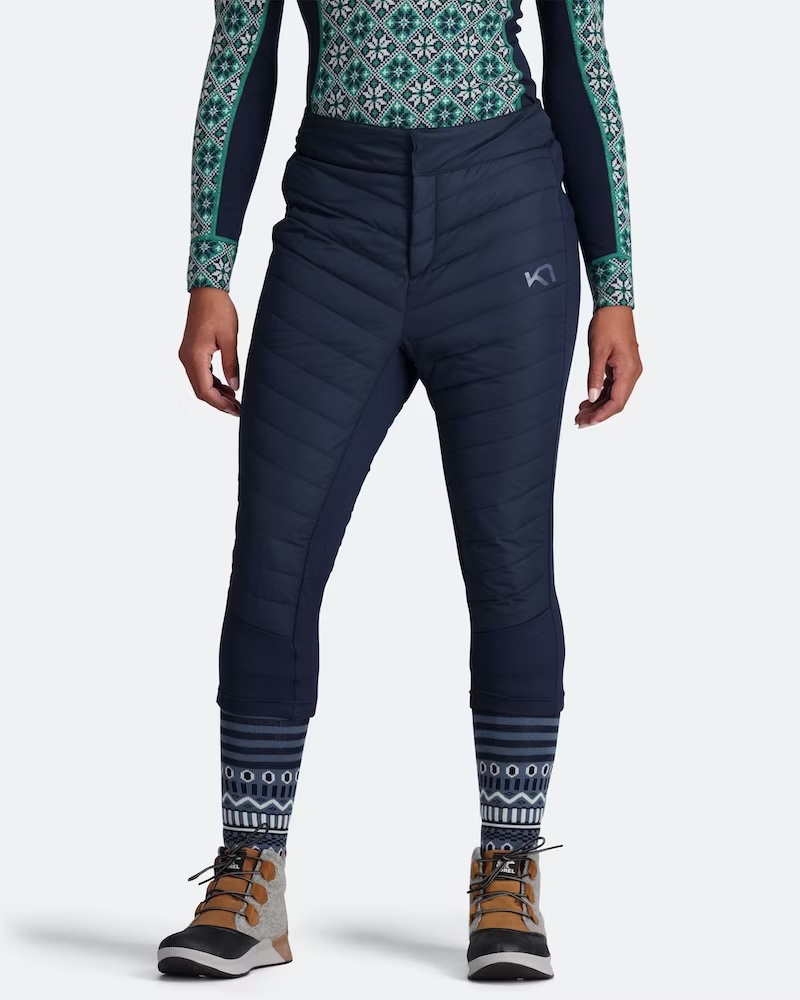
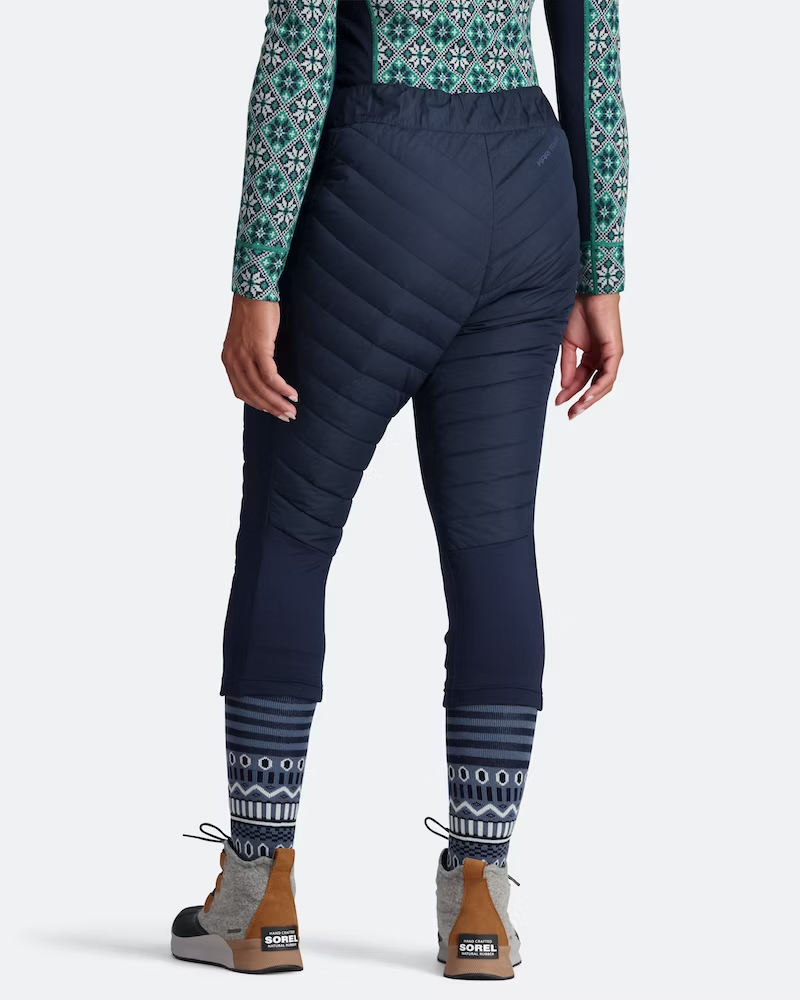
I do like that the Eva’s insulation is only placed where it is needed — on the front and back of the legs. When sitting, the insulation ends at my knee, with no insulation behind or on top of it. These are the warmest capris I have and if you’re looking for warmth, this is a great option — especially if your legs are a bit shorter than mine. If you want something a bit less warm / more breathable, check out the Stio Fernos Insulated Knicker or Strafe’s Alpha Insulator Pant.
Strafe Women’s Alpha Insulator Pant
MSRP: $249
Fabric: 20D Recon AIR stretch mini rip-stop (100% nylon | 53-g/m2)
Insulation: 80-g/m2 Polartec Alpha (100% Recycled Polyester)
Measured Weight: 263 g
Size Tested: Medium
Reviewer: Kristin Sinnott (5’8”, 135 lb / 172 cm, 61 kg)
With its recently added 2-way side zippers, the Strafe Alpha Insulator Pant is one of the most versatile midlayer bottoms I’ve worn. You can fully unzip both sides, which is great if you need insulation for only part of the day and you don’t want to go through the hassle of removing ski pants, boots, etc. That makes it ideal for ski touring, skimo, cross-country skiing, or any active winter sport.
The Alpha Insulator Pant’s lightweight Recon Air fabric, combined with its soft Polartec Alpha insulation, makes for a breathable piece of insulation. Combined with the fabric’s DWR finish, the Alpha Insulator Pant can be worn as a midlayer or as an outer layer (though I wouldn’t recommend subjecting them to lots of tree branches and rocks; the fabric is quite light).
The Alpha Insulator Pants are the shortest capri pants I tested. With an inseam of 18.5 in / 47 cm for a size Medium, they fall just below my knee, but with their well designed articulated knees, they don’t ride up when my knee is fully bent. There are no tapered cuffs on these pants, which adds to their versatility when being worn as an outer layer.
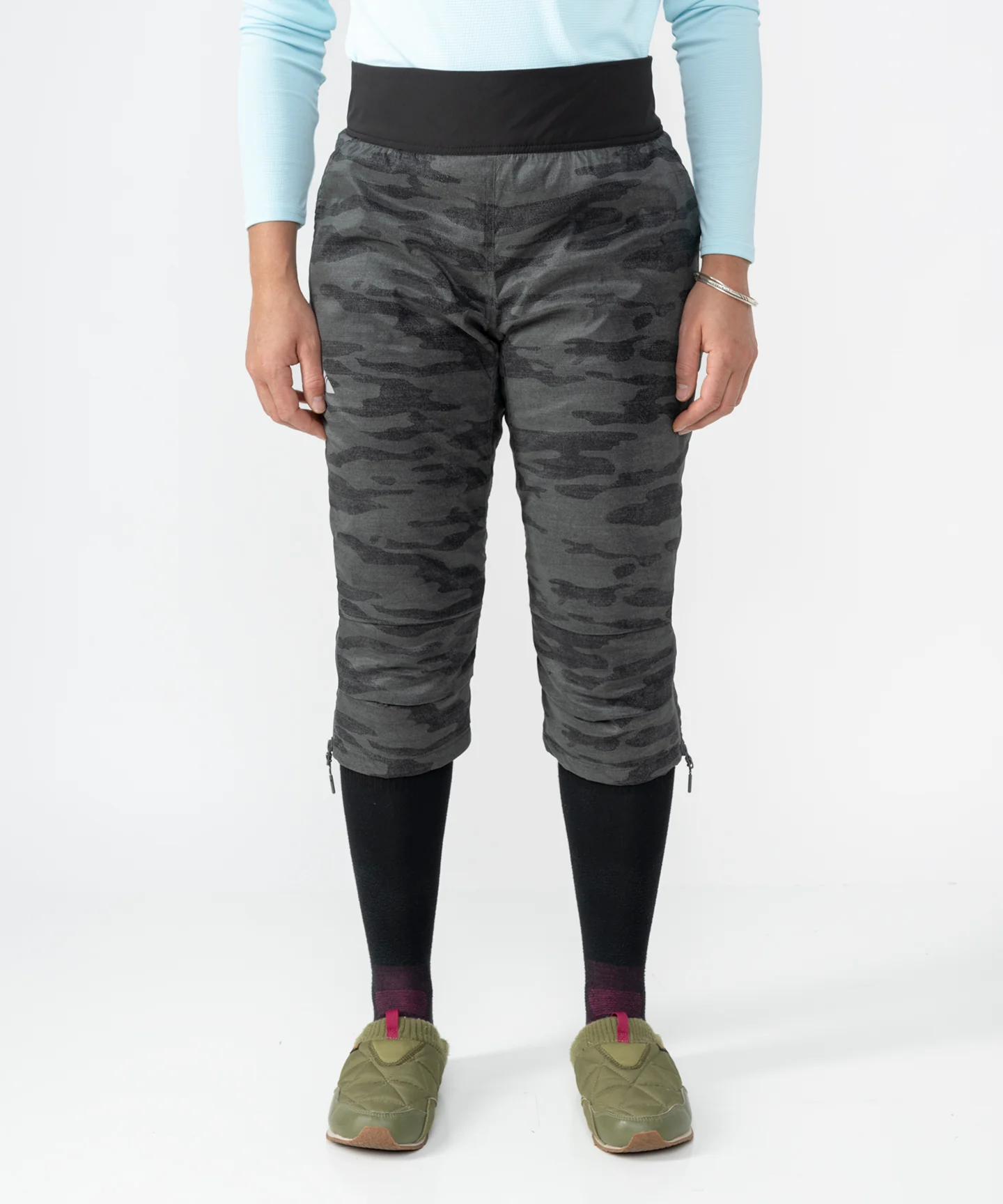
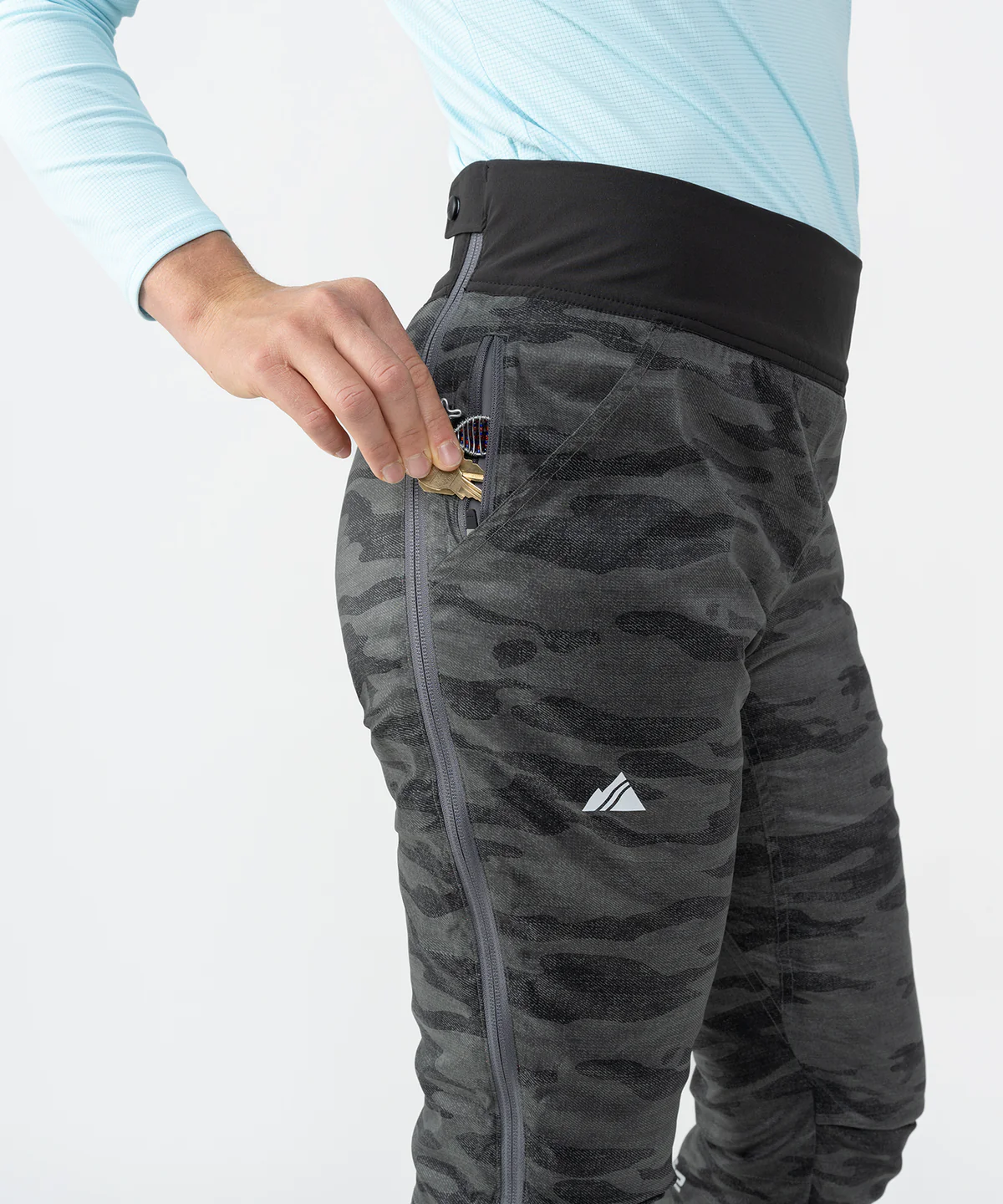
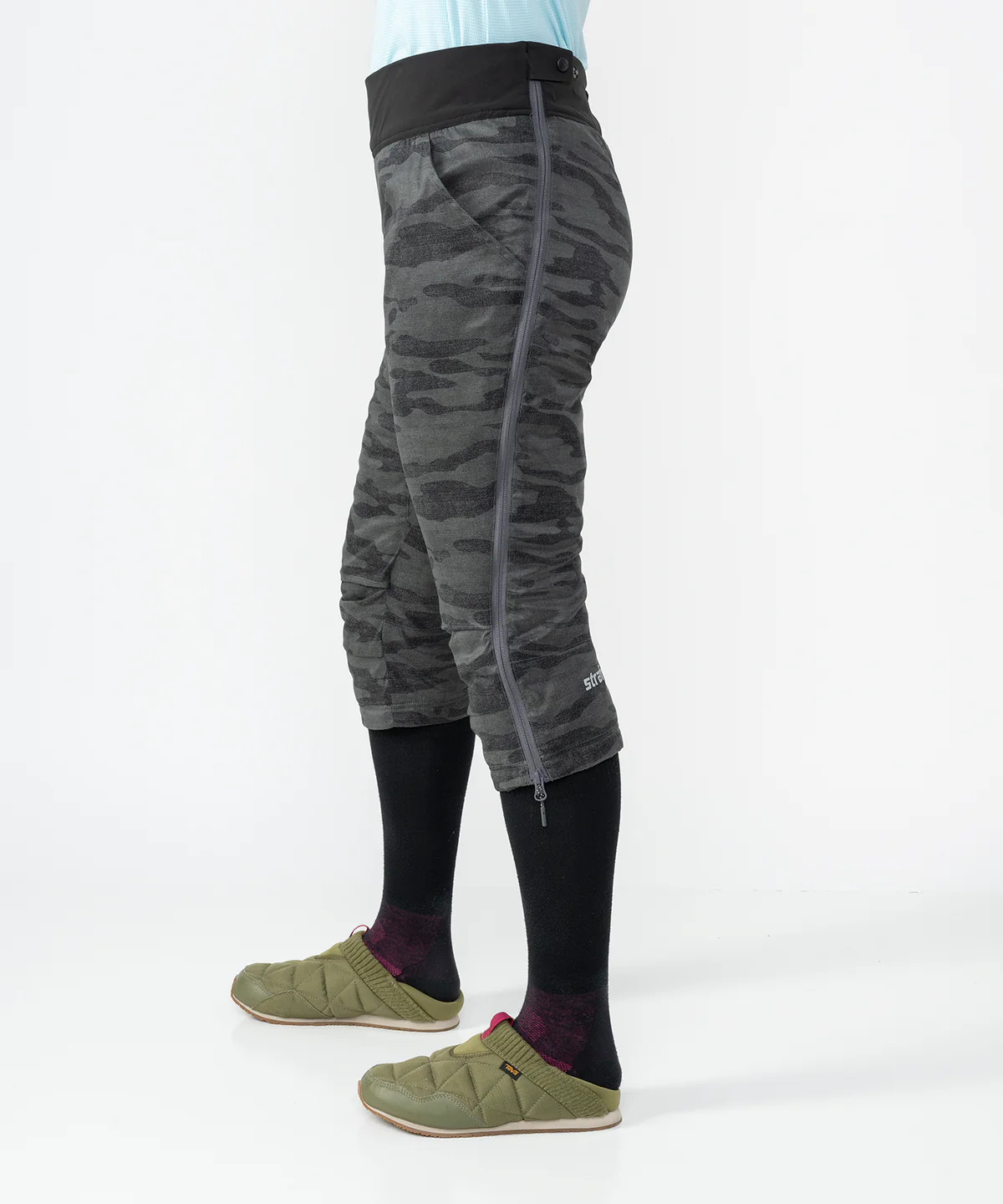
For me, the standout feature of the Alpha Insulator Pant is its full leg zippers. I like to wear them on cold mornings, but as the day warms up — and this is especially true if I’m hitting any hike-to terrain — my legs start to sweat. The double zippers allow for easy ventilation, paired with the exterior vents on my ski pants, and opening them up like this immediately cools me down. But I also love how easy they are to remove — I can unzip them and take them off while still wearing my ski pants and boots.
Unlike the Stio Fernos and Kari Traa Eva, the waistband on the Alpha Insulator Pant features a wide 4-way stretch fabric and a double snap system on the sides that provides two sizing options. With dual hand pockets and a hidden zipper pocket for small items, the Alpha Insulator pant is a versatile option for people looking for an active-insulation bottom.
Skhoop Aluu Pants
MSRP: $199
Fabric:
Shell: 100% polyester
Stretch Panels: 93% Nylon / 7% Spandex
Insulation: 60-g/m2 synthetic (100% polyester)
Measured Weight: 410 g
Size Tested: Medium
Reviewer: Kristin Sinnott (5’8”, 135 lb / 172 cm, 61 kg)
Since moving to Mt. Crested Butte, I’ve gotten back into cross-country skiing and I’ve been spending a lot more time outside in cold weather. I also joined a master’s XC ski group, which means that I need to be outside skiing at a certain day and time every week. No fair-weather snowplay for me.
Prior to getting the Skhoop Aluu Pants, I was dreading the cold days and wasn’t sure what I would wear for my 4:30 pm intervals. Thankfully, the Aluu pants arrived right before this winter’s first real cold spell and, since then, they have kept me warm and happy while out on the trails.
The Aluu pants are a fairly versatile layer in that I find myself wearing them with or without a baselayer, depending on the temperature. When paired with tall ski socks, the Aluu pants keep my legs warm without causing me to overheat on days where the temps range from roughly 20-30+°F (-6 to over 0°C). Anything colder than that and I add a baselayer underneath.
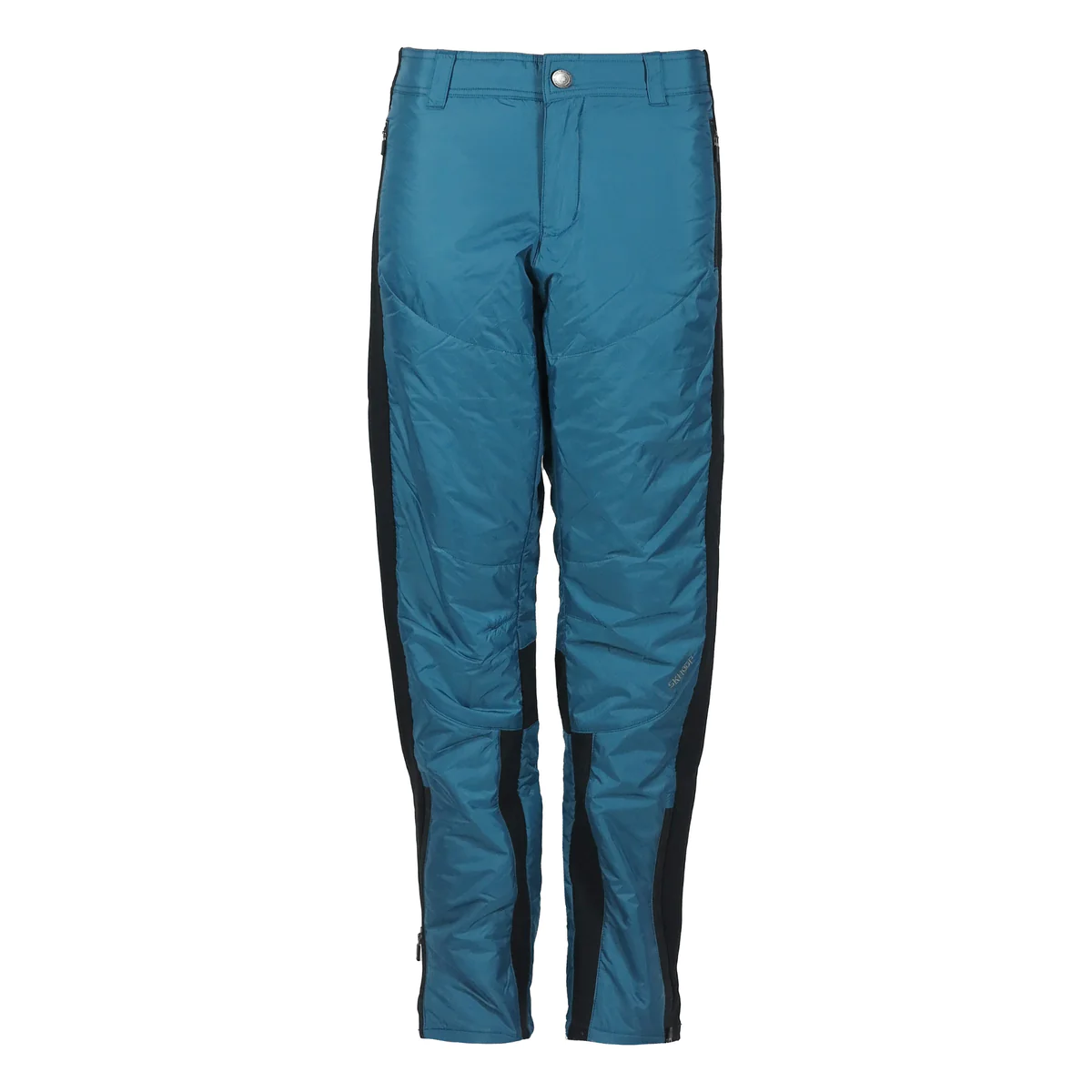

I’ve only ever worn the Aluu Pants as an outer layer and I’ve found them to be plenty wind resistant for the XC downhills and windy days. The Aluu pants have a DWR finish and, while I haven’t had them long enough to test the long-term durability of the DWR, I don’t plan to wear them as an outer layer in very wet or blizzard-like conditions.
The paneling on the Aluu’s outer leg, inside lower leg, and behind the knee features a tight-weave exterior with a soft lining. The elastic side panels provide enough stretch for good mobility when walking, or when out for a skate or classic ski. And the 60-g synthetic insulation isn’t overly bulky so it doesn’t impede my mobility and I haven’t found myself prone to overheating in these pants when the temperatures are below freezing.
The Aluu’s lower leg has a 10 in / 25 cm zipper that allows access to the lower leg – great for pulling up socks or to help get the pant leg over a cross-country boot. And while I like this zipper, it is also the reason I don’t plan to wear these pants while alpine skiing or with my tall Fubuki snow boots. With my taller, bulkier boots, the zipper digs into my leg, and trying to roll the cuff only results in mediocre success. In general, these pants are warm enough that I usually forgo the big warm boots and instead pair them with my cabin shoes or smaller boots.
The inseam of the size Medium Aluu pants is 31 in / 79 cm, which is slightly long on me when wearing around the house, but I wouldn’t downsize. The Medium fits me well in the waist and, with its elastic and belt loops, there is room for dialing in the waistband if needed.
Skhoop Original Skirt
MSRP: $129
Fabric: 100% Polyester
Insulation: 80-g synthetic (100% Polyester)
Measured Weight: 314 g
Size Tested: Medium
Reviewer: Kristin Sinnott (5’8”, 135 lb / 172 cm, 61 kg)
Of all my insulated bottoms, Skhoop’s Original Skirt has gotten the most use. I love this skirt! I was first introduced to it 5+ years ago when my sister-in-law, an XC-ski coach, received one and I was a bit envious. At the time, I was living in Santa Fe, New Mexico and the climate didn’t seem cold enough to warrant a long insulated skirt. Instead, I opted to try various shorter insulated skirts. Fast forward to this winter ,and I wear the big Original Skirt almost every day.
The skirt filled with an 80-g synthetic insulation, which I haven’t found to be annoyingly bulky or heavy. And, turns out, I was wrong to assume that Santa Fe was too warm to warrant this skirt — it’s a great layer even on fairly warm winter days where the temperatures are around freezing. I tend to throw it on over whatever pants I’m wearing (typically leggings or baselayers) on my commute to the ski area. The dual-zip closure (full-length on one side, part-length on the other) makes it very easy to put on / take off, and I keep the skirt on the coat rack so it’s easy to grab every day.
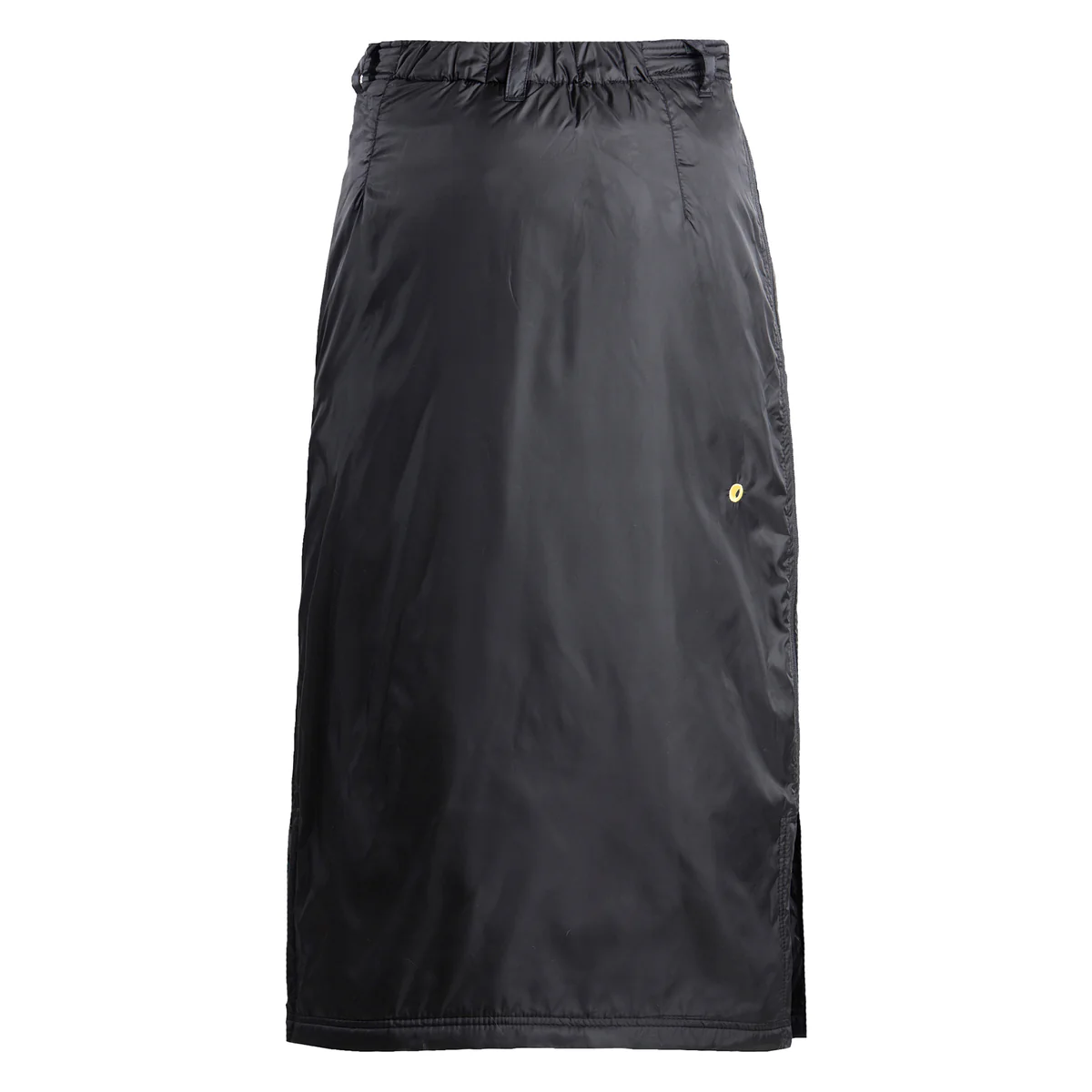

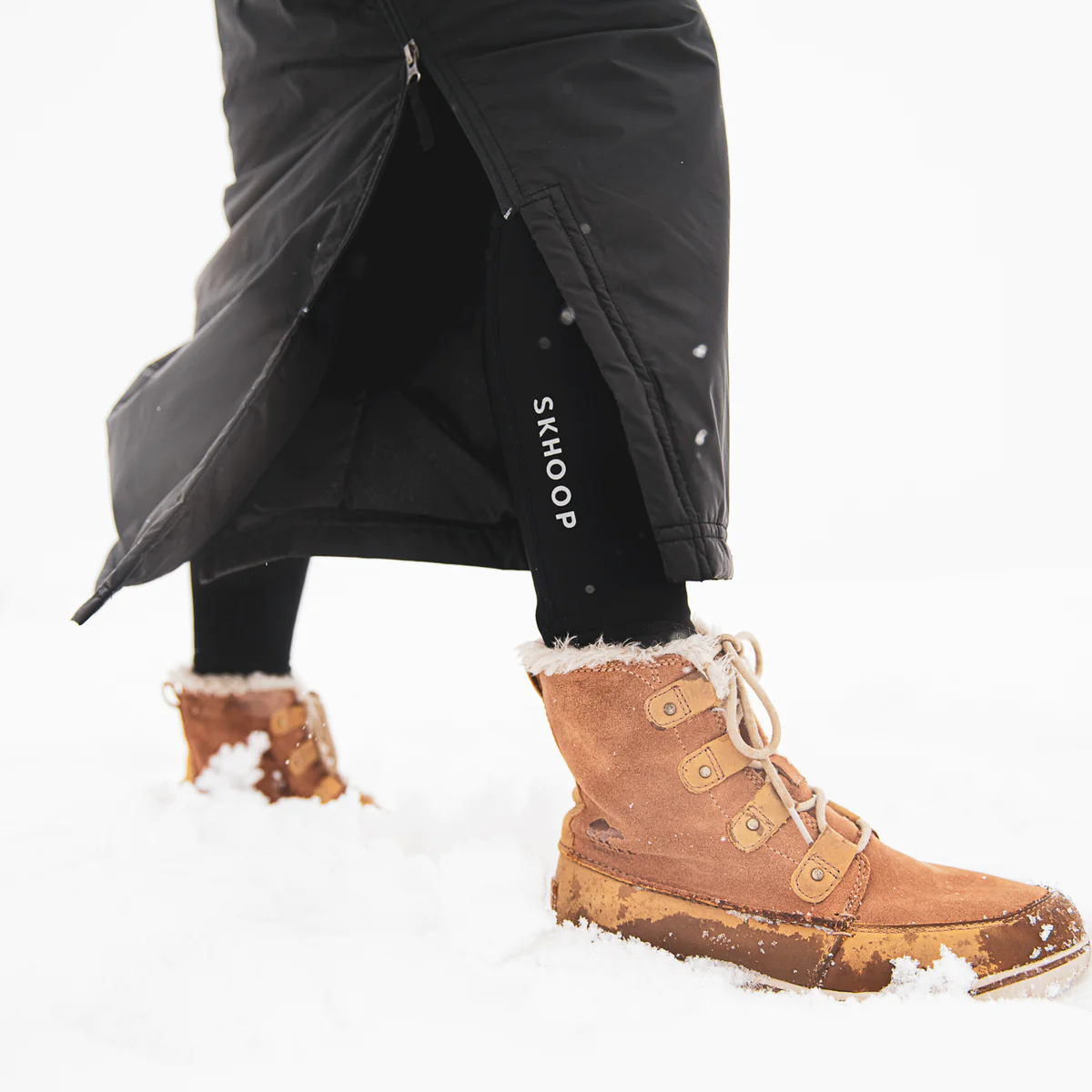
With zippers on both sides, the side slits can be adjusted, depending on the activity or inactivity. I typically keep both zippers slightly unzipped when walking, but when standing around (e.g., watching a torchlight parade or something), I zip it down to stay cozy.
Voormi Women’s High-E Hoodie
MSRP: $249
Fabric: Surfaced Hardened Thermal Wool (350 g/m2)
Measured Weight: 409 g
Size Tested: XS
Reviewer: Sascha Anastas (5’1”, 105 lb / 155 cm, 47 kg)
Voormi’s High-E Hoodie has been around for quite some time but has remained a go-to option in my closet. This Colorado apparel company actually launched the High-E Hoodie as their very first piece back in 2013, almost 10 years ago. However, the High-E Hoodie still remains relevant today due to its durability and patented “Surface Hardened Thermal Wool” fabric. To dive deeper into Voormi’s tech and background, you can listen to our GEAR:30 podcast episode with Voormi’s CMO, Timm Smith.
In short, the High-E Hoodie uses a thin wool knit fabric that has a “hard” face on the exterior and a DWR treatment, for improved weather resistance, relative to most other knit fabrics.
As for the product itself, the High-E Hoodie features both a half-length zipper and balaclava-style hood. The collar is tall enough to come up over my mouth and nose, and the thin fabric means it fits snugly under my ski helmet. As with the Outdoor Research Vigor Grid Fleece Pullover, the High-E Hoodie also features a ponytail slot to minimize bulk behind the neck. Its wrists do have thumb slits but the sleeves are slim enough to keep the fabric in place, so I tend not to use the thumb slits.

In short, the High-E Hoodie uses a thin wool knit fabric that has a “hard” face on the exterior and a DWR treatment, for improved weather resistance, relative to most other knit fabrics.
As for the product itself, the High-E Hoodie features both a half-length zipper and balaclava-style hood. The collar is tall enough to come up over my mouth and nose, and the thin fabric means it fits snugly under my ski helmet. As with the Outdoor Research Vigor Grid Fleece Pullover, the High-E Hoodie also features a ponytail slot to minimize bulk behind the neck. Its wrists do have thumb slits but the sleeves are slim enough to keep the fabric in place, so I tend not to use the thumb slits.
I’d say the High-E Hoodie fits mostly true to size with the exception of feeling slightly snug in the upper back and arms (I have it in my usual size of XS). Because of its “hardened” face, the fabric does feel a little stiff relative to most other fleece-like layers, especially in the shoulder area when putting on the hoodie. Once the hoodie is on and I’m moving around, the stiffness was much less apparent. The overall fit is also pretty snug so I tend to wear a thin baselayer underneath or just wear the High-E Hoodie as my on-skin baselayer in warmer temps. The inner surface of the High-E Hoodie is fleece-like in most zones, making it cozy when worn with nothing else underneath.
Due to its ability to wick moisture, provide some warmth, and fend of some light wind and snow, I most often wear the High-E Hoodie as my outer layer during high-output activities where I tend to sweat but also need to stay warm (e.g., Nordic skiing & ski touring). I also gravitate toward the High-E Hoodie on most cold fall days of mountain biking, especially at higher elevations, since it breathes much better than most warmer, thicker midlayers and shells but offers a bit of weather protection.
For really cold days of resort skiing, I often wear the High-E Hoodie over a thin baselayer, under my ski bibs, and under another puffier midlayer or insulated shell.
So if you like the idea of a layer that can function as a warm baselayer or highly breathable midlayer — and you want some added wind and water resistance, relative to most similarly breathable fleeces — the High-E Hoodie should be on your list.
Ortovox Swisswool Hybrid Short Pants
MSRP: $220
Fabric: Merino Fleece Light (67% polyester / 26% virgin merino wool)
Insulation: 60-g/m2 SwissWool (80% virgin wool / 20% polylactide)
Measured Weight: 145 g
Size Tested: XS
Reviewer: Sascha Anastas (5’1”, 105 lb / 155 cm, 47 kg)
I am a big fan of insulated ski pants and prefered to wear them almost every day I am riding chairlifts — regardless of the temperature. However, there aren’t a whole lot of them that come in XS sizing and a length that works for my petite frame. With that in mind, the Ortovox Swisswool Hybrid Short Pants have been a gamechanger for me, in that I can now happily wear uninsulated bib / pant shells even on the coldest of days, as long as I layer these hybrid short / pants underneath.
The Swisswool Hybrid Short Pant features panels of Ortovox’s 60-g SwissWool insulation on the front and back of the thighs. The sides of the pants, the crotch area, and cuff around the knee feature Otorvox’s elastic Merino Fleece Light inserts, which make it really easy to move around and add versatility in the form of increased breathability in those areas. The cuffs are made from a very thin and elastic material which easily goes over my ski-sock cuffs with minimal added bulk. Up top, the elastic band is 2 inches wide and fits snugly but does not feel constricting.
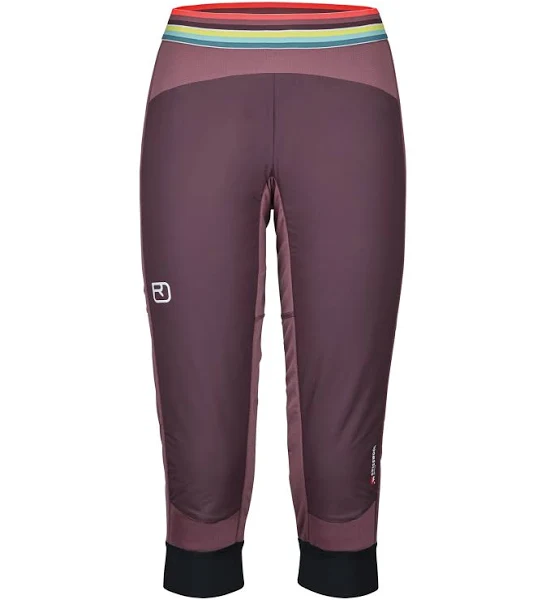

I’d say the Swisswool Hybrid Short Pants fit true to size. Even though there is some elasticity on the sides, cuffs, and waistband, they’re not wildly stretchy to the point that they bag down. I have found that, when I have shorter-length ski socks, there’s sometimes a gap between the top of my sock and the cuff of the Swisswool Hybrid Short Pants. This could likely be avoided by tucking the pant cuff into the top of the sock, but I prefer to avoid layering anything between my skin and my ski socks. Like Kristin and here experiences with some ¾-length insulated bottoms, I will ocassionally wear a thin baselayer under the Swisswool Hybrid Short Pants, which resolve this gap issue.
For some people, the SwissWool Hybrid Short Pant could be a nice luxury on really cold days, but since I tend to get cold a lot easier than most, an insulated midlayer like this is now an absolute must. I doubt there will be many inbounds ski days when I opt to forgo these comfy, warm pants. If you run hotter and want something a bit lighter and more breathable, the Ortovox Fleece Light Short Pant may be a better option.


